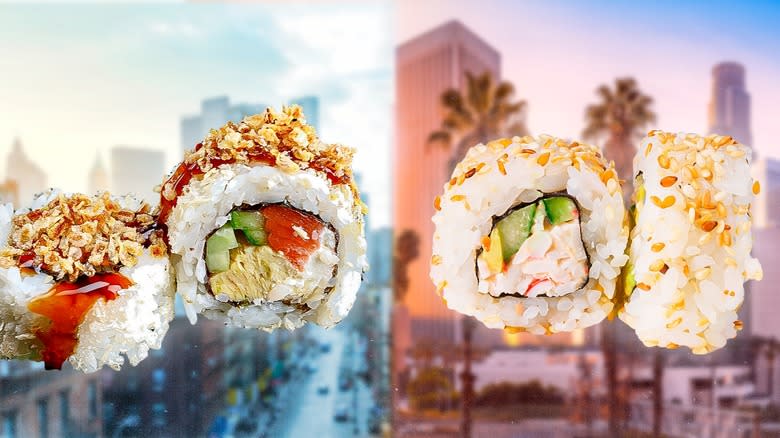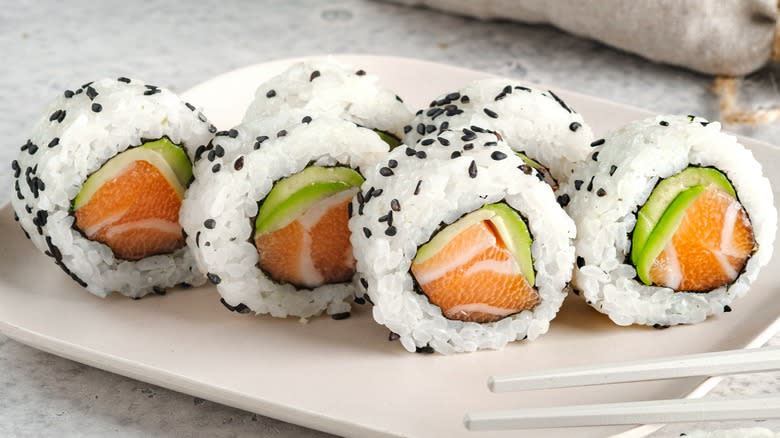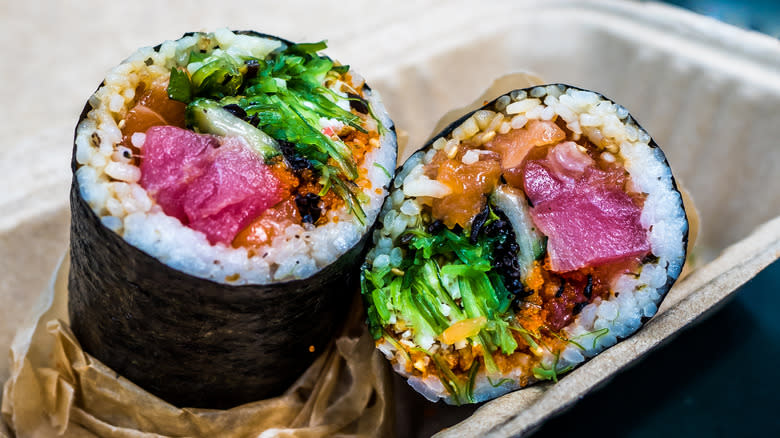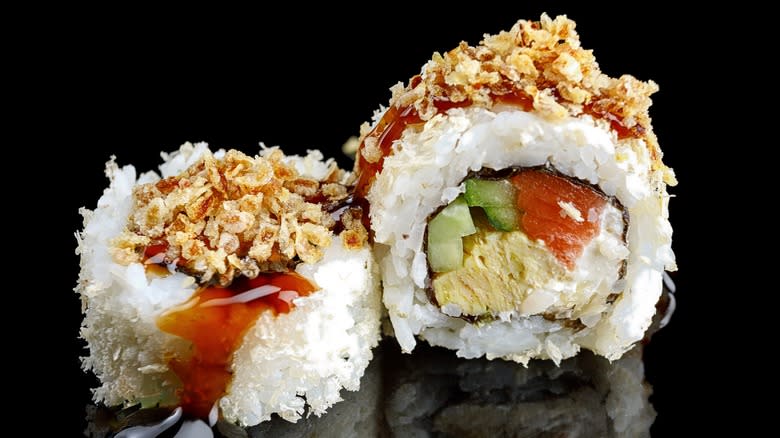Is There Really A Difference Between East And West Coast Sushi?

Differences between sushi orders in North America compared to those rolled up in Japan are fairly easy to pinpoint. Ingredients, style of dishes, the etiquette surrounding how sushi is made and served, and the ways dishes are eaten are a few of the noticeable ones. While Japanese sushi is known for its simpler, traditional approach, Western-style recipes commonly add extra ingredients for pops of flavor and colorful presentations. You won't as easily find tempura, cream cheese, or mayo tucked into sushi bites in the East. Rice, too, can differ, as Western chefs look to pack flavors and colors into pieces. Yet what about from one coast of the United States to the other?
After entertainer Andy Milonakis took to the Food is the New Rock podcast to declare a line in the sand between sushi hailing from opposite coasts in America, declaring New York sushi to be better than that in L.A., we wanted to take a closer look at sushi made in North America and the ongoing debate that sushi found on the two opposing shores have sparked.
Read more: Restaurant Foods That Always Taste Better Than What You Make At Home
West Coast Beginnings

West Coast sushi has history in its favor, as we have chefs on that side of the country to thank for the introduction and rise of sushi in the United States. When Japanese immigrants made their way across the Pacific, they brought their cuisine with them. In 1906, the first recorded sushi shop opened in Los Angeles. Socialities and themed parties helped push sushi recipes into mainstream culture, and creations such as the California roll encouraged the scene to grow. The California roll bridged the gap between familiar and unfamiliar, as it made some of the ingredients Americans were uncertain about a bit more palatable by its use of crab sticks rather than fresh raw fish. San Francisco, too, is home to some great sushi restaurants, thanks in part to it also becoming home to many Japanese immigrants in the early 20th century.
And Vancouver, with its water-focused culture, has also made a sushi name for itself, with hundreds of sushi restaurants running successful operations. It was even named sushi capital of the world outside Japan in 2022 by Chef's Pencil. Access to high-quality fish and seafood has offered chefs up and down North America's West Coast the ingredients needed to garner appreciative accolades from sushi lovers. And many sushi establishments run happy hour specials to make meals more affordable and accessible for those with persistent sushi cravings.
Sushi Experiences On The East Coast

On the East Coast of the United States, the sushi scene has earned reputation as a place in which some of the best quality seafood and sushi can be found. New Yorkers have their pick from sushi counters and orchestrated dining experiences, and with Michelin-starred recognition, some New York City sushi restaurants are giving Tokyo establishments a real run for their money.
From the 12-seater Shiki Omakase to Masa in Columbus Circle, East Coast sushi lovers certainly have options when it comes to finding exceptional sushi. But of course there are many more places to suit not only their palates but also their pocketbooks. Like California, New York City has lent its name to its own sushi roll that serves up sushi rice, seaweed, cucumber, and avocado in a cute package. Where the California roll includes crab in the recipe, the New York roll replaces the fish with shrimp.
Online Debates On Coastal Preferences

The quality of sushi served on the East and West Coasts has sparked a lively debate online, with sushi lovers insisting the waters of the West Coast lend to the kind of dishes that are on par with what is tasted in Japan. Even The New York Times declared Los Angeles as "this country's glorious sushi capital," describing the region as home to one of the top flourishing sushi areas outside of Japan. There are certainly exceptional L.A. sushi restaurant options and many dedicated sushi chefs creating a continuum of beautifully plated dishes to packaged rolls served up in takeout containers.
"L.A. has things that will dance on New York's food scene," Jon Shook boldly told High Brow Magazine. While Shook points to the range of quality seafood available on the East Coast as a deciding factor, he suggests that L.A.'s proximity to Japan is key to settling the debate. He conceded that great fish is shipped from the East Coast to the West Coast. "Sushi [in L.A.] is a whole different level," he insists.
While quality seems to be the driver of these debates, the truth is that there isn't any real difference between what is served on either coast. And although here at Tasting Table, we are hesitant to name a favorite, weighing up the arguments on both sides, it seems that the happy truth is that there are sushi restaurants on both coasts that are well worth trying.
Read the original article on Tasting Table.

